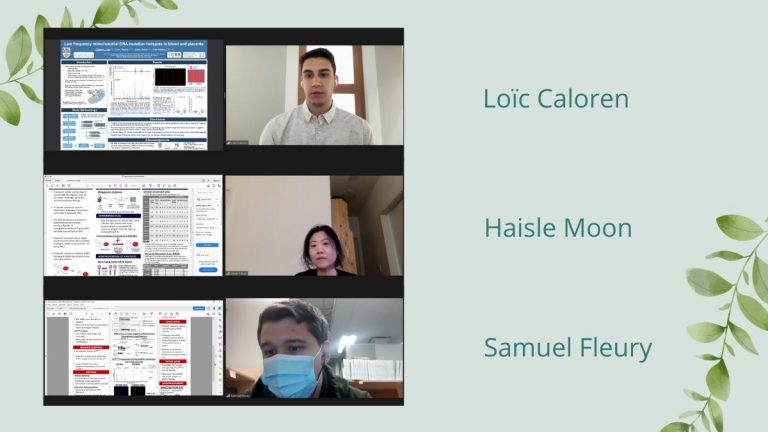
 By Andy An, PhD/MD Student, Hancock Lab, and Calem Kenward, PhD Student, Strynadka Lab
By Andy An, PhD/MD Student, Hancock Lab, and Calem Kenward, PhD Student, Strynadka Lab
On May 18th, 2021, the 10th Annual Norman Bethune Symposium was held virtually for the second year to great success. At this Centre for Blood Research (CBR) event, presenters shared insights on advances in patient blood management, challenges in trauma-induced bleeding, and disorders of red blood cell (RBC) metabolism, among many other exciting topics.
A morning of bleeding-edge talks and an interactive virtual poster session
The symposium began with an engaging talk by Dr. Daniele Prati (Policlinico di Milano, Italy), in which he highlighted how ABO blood type can influence susceptibility to SARS-CoV-2 infection. Their findings suggest that O type is potentially protective against infection. This was followed by Dr. Rebecca Cardigan (NHS, UK), who described her work to create an ABO universal plasma by using a specialized filter material to remove anti-A and anti-B antibodies from plasma.

For the symposium’s first presentation, Dr. Daniele Prati presents an exciting and timely talk on “ABO blood type and susceptibility to SARS-CoV-2 infection”.
Attendees then participated in a virtual poster session, with 14 participants presenting on diverse research topics related to hemostasis. Topics included the application of gene therapy to decrease clotting, improving blood products through cold storage, mRNA therapy, machine learning, and developing a novel anti-antithrombin RNA aptamer. Timely research on the SARS-CoV-2 spike protein and ACE2 interactions in COVID-19 were also shared. This year, poster presenters also created 90-second video poster pitches to provide a sneak peek of their research. Making an engaging and interesting 1.5-minute video is harder than one might think, so well done to all!
The symposium then moved on to its first set of trainee talks. First, Andy An (UBC) discussed the role of the calcium-binding protein S100A9 in reprogrammed macrophages to better understand the dysregulated immune response in sepsis. This was followed by Emel Islamzada (UBC), who shared how RBCs for transfusion can change in deformability over time in storage, which has implications on RBC unit quality in the clinic. Finally, Massimo Cau (UBC) presented promising results on using a hemostatic powder of self-propelling particles to stop intra-abdominal hemorrhages, which are a common cause of preventable death on the battlefield and in civilian accidents.
After this first round of trainee talks, Dr. Jeannie Callum (Queen’s University) discussed the results of the FARES study, a pilot randomized clinical trial which compared regular plasma to prothrombin complex concentrate (PCC) after cardiovascular surgery. The trial indicated that PCC has superior hemostatic effects without increased adverse events compared to frozen plasma, warranting a larger multi-centre clinical trial. Next, Dr. Richard Francis (Columbia University) discussed how glucose-6-phosphate dehydrogenase (G6PD) deficiency adversely affects RBC storage quality via increased sensitivity to oxidative stress. Dr. Francis guided listeners through a thorough mechanistic and metabolic explanation for this phenomenon, and highlighted the value of screening blood donors for G6PD deficiency to inform storage conditions or choices about using these products in chronically transfused patients.
After a health break, the second round of trainee talks began with Dr. Basit Yousuf discussing transcriptomic analyses of Staphylococcus aureus, a common contaminant in platelet concentrates. His study could help improve the screening of platelet products and safety of platelet transfusions. Nancy Yang (UBC) described how multiple chronic viral infections may lead to accelerated aging seen in HIV patients, leading to poorer quality of life due to an earlier onset of age-associated diseases. Finally, Liliana Jiminez (UBC) investigated the use of platelet factor 4 as a potential biomarker in juvenile idiopathic arthritis, the most common inflammatory rheumatic disease in childhood.
From transfusion for childhood oncology to managing bleeds on Mars
During the afternoon sessions, speakers highlighted the huge range of patient needs encountered in transfusion medicine: from the needs of the US army to a very personal story of childhood oncology, and from safe access to transfusion in low-income African countries to managing bleeding in places as far away as Mars!
Beginning this series of talks was Dr. Andre Cap, who summarized past and ongoing developments in bleeding trauma therapies in use by the US Armed Forces. Next, we heard from Dr. Marianne Nellis from Weill Cornell Medical College, who shared some surprising results about the association between the age of transfusion products and adverse outcomes in pediatric patients, finding that fresher platelets appear to be independently associated with febrile transfusion reactions. During a heart-wrenching interlude, Sharon Bulger shared the story of her son Cameron’s battle with stage 4 cancer and the importance that blood transfusions played throughout the course of his chemotherapy and experimental drug trials. Returning to transfusion medicine, Dr. Meghan Delaney (National Children’s Hospital, Washington DC) highlighted the importance of blood transfusion availability in low- and middle-income nations, and the importance that local health programs can have on patient outcomes.

A group photo screenshot of some attendees and speakers at the 10th Annual Norman Bethune Symposium, who joined virtually from around the world to share in the event’s activities.
The afternoon saw a third round of student talks, with Wenjing Xia (UBC) sharing her work on the role of type 2 Innate lymphoid cells in tumour immunity. Dr. Alex Leatherdale (UBC) presented on how persistently elevated complement alternative pathway biomarkers in COVID-19 correlated with hypoxemia and can be used to predict in-hospital mortality. Concluding these talks, Nabil Ali-Mohamad (UBC) shared his work on using extra-terrestrial soils to activate coagulation factor XII and manage bleeding, and possible implications for hemorrhage control during space exploration. Rounding off the talks for the day were Dr. Mypinder Sekhon and Dr. Ryan Hoiland (VGH ICU & Neurointensivist), who presented their work on determining the impact of blood transfusion on cerebral blood flow regulation in experimental and pathological brain hypoxia in humans.
Concluding the symposium, we heard from the Director of the CBR, Dr. Dana Devine, who was an excellent host throughout event. The poster presentation winners were announced – congratulations to Samuel Fleury (Lordkipanidzé Lab, Université de Montréal) and Haisle Moon (Kizhakkedathu Lab), who took joint second place, and Loïc Caloren (Côté Lab) who was awarded first place, as well as the People’s Choice Award for his video poster pitch!
Finally, a special thanks to the sponsors, without whom the event would not have been possible: Roche, Pfizer, the Canadian Blood Services, Grifols, and the Naiman-Vickars Endowment Fund. We would like to thank all of the speakers, attendees, and organizers. With everyone’s participation and support, the symposium was an insightful and memorable event, and we look forward to seeing you all again in the fall for the CBR’s annual Earl W. Davie Symposium!
- Learn more about the Norman Bethune Symposium with the Canadian Blood Services’s blog: Diverse talks that informed and inspired – Norman Bethune Symposium 2021
- Watch the recording of the 10th Annual Norman Bethune Symposium
- Watch the 90-second video poster pitches created by poster presenters, which give a snapshot into their research topics

The first-place winner of the virtual poster session, Loïc Caloren from UBC, as well as the second-place winners, Haisle Moon from UBC and Samuel Fleury from Université de Montréal.


